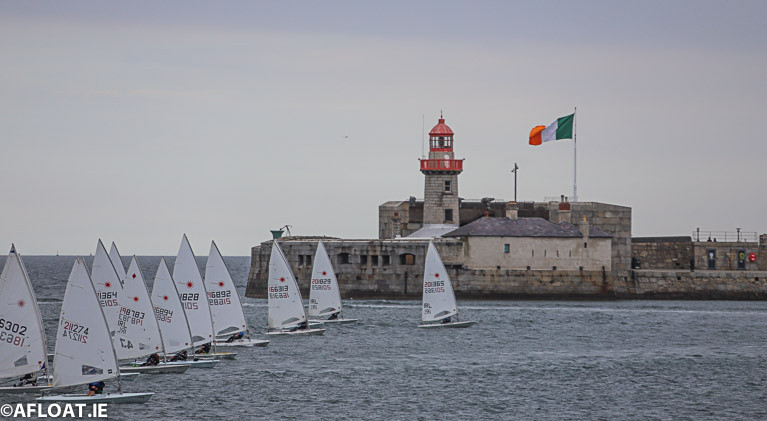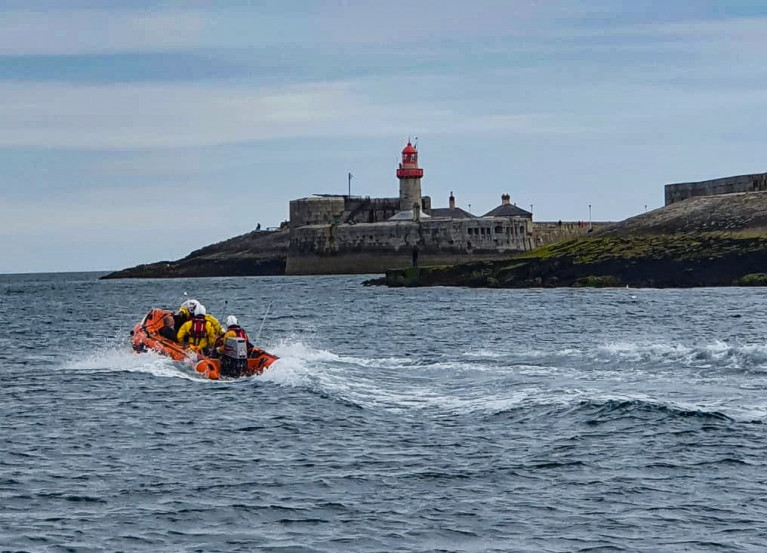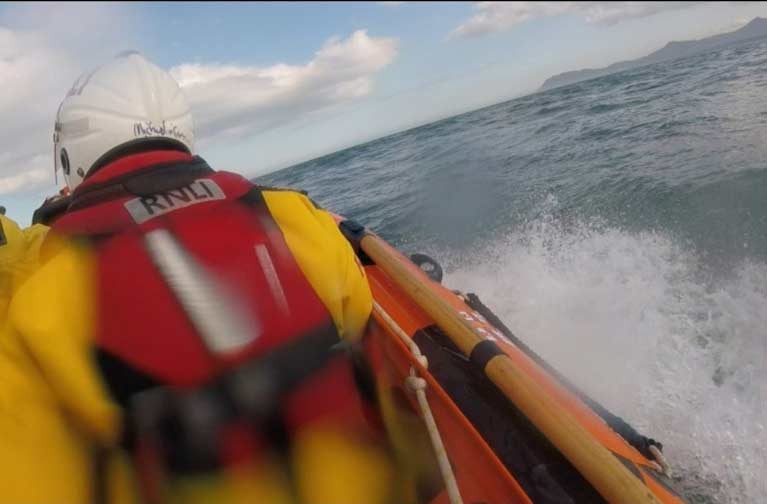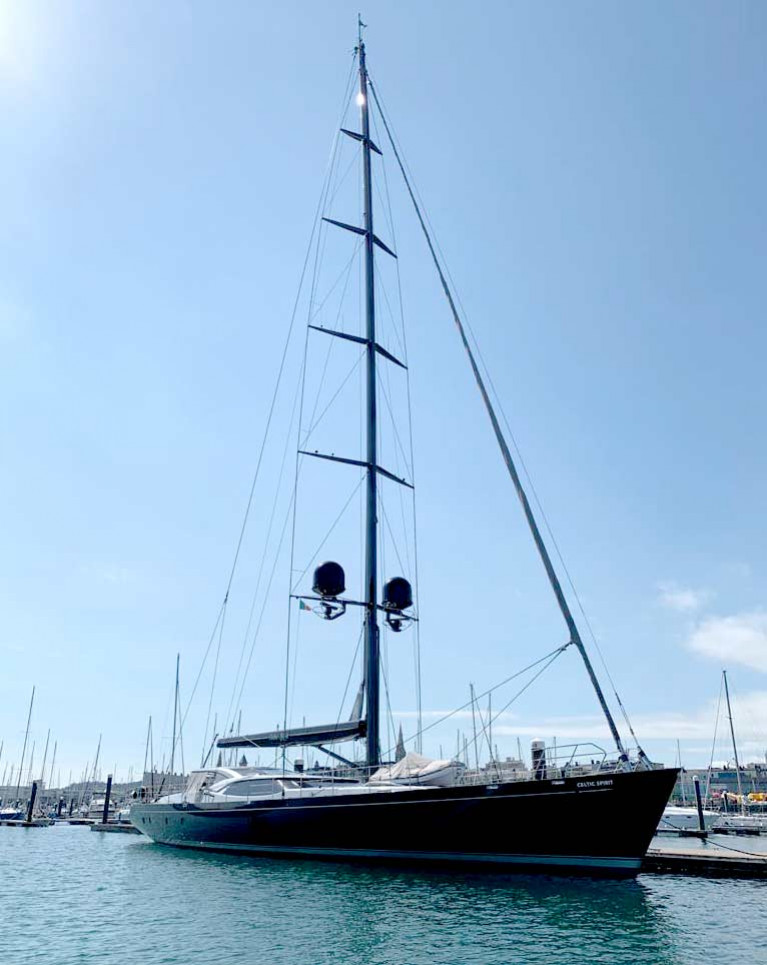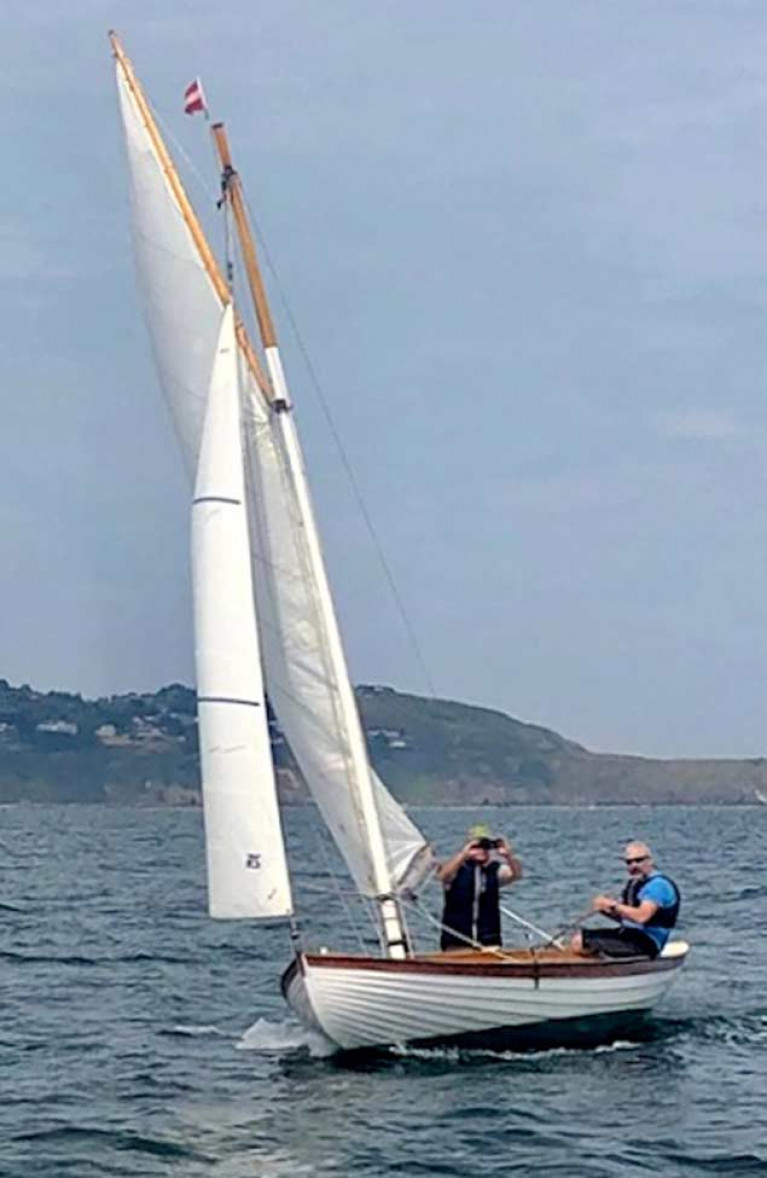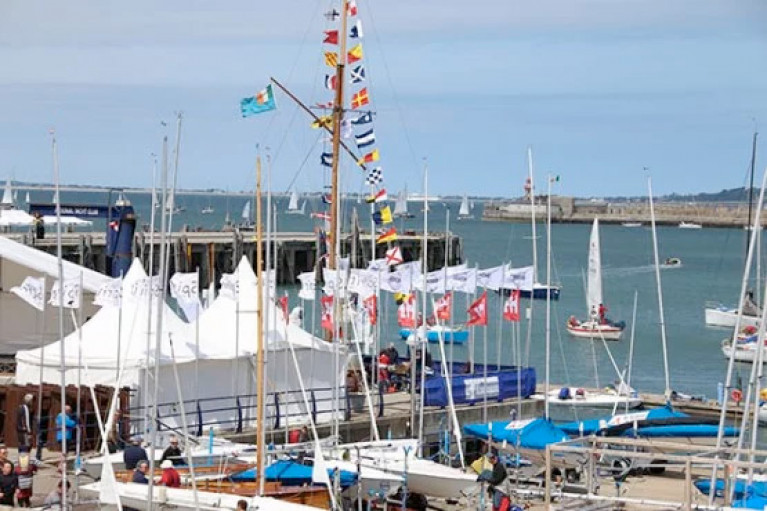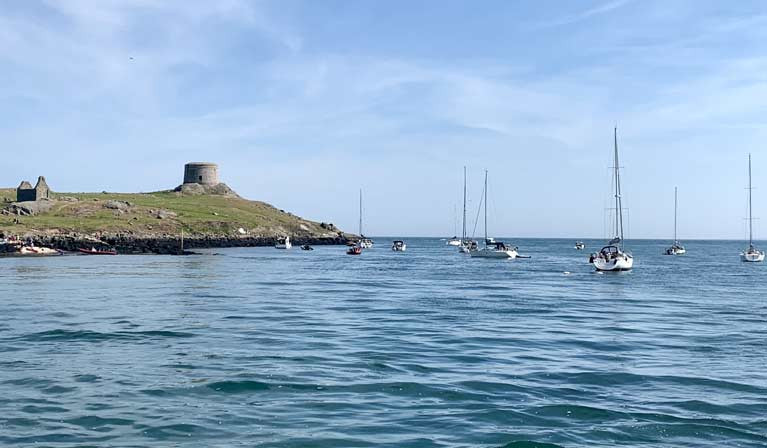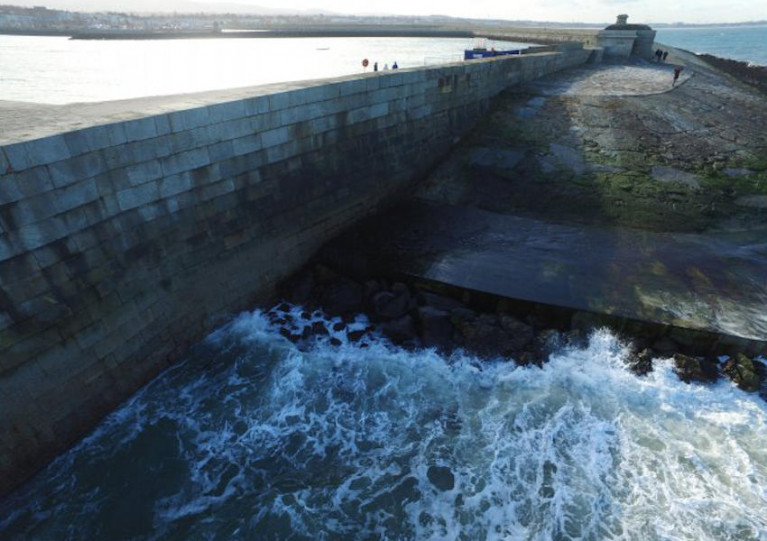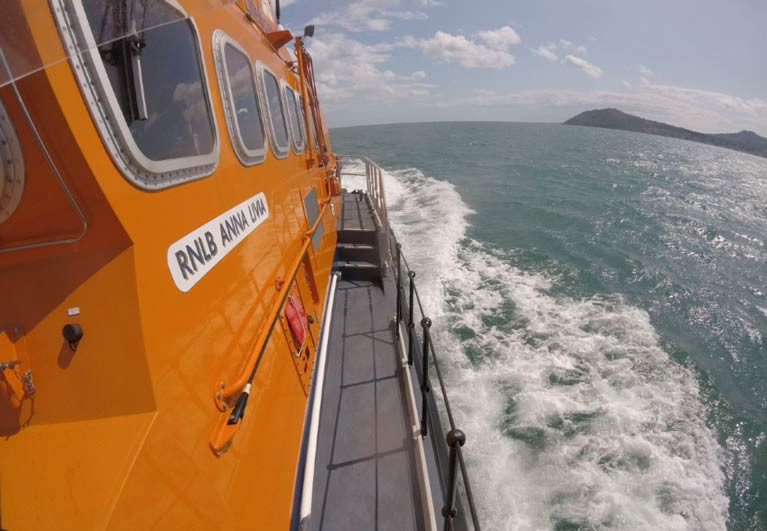Displaying items by tag: Dun Laoghaire Harbour
Laser DBSC Dinghy Racing Resumes with Big Fleet at Dun Laoghaire Harbour (Results HERE!)
Tuesday evening Dublin Bay Sailing Club (DBSC) dinghy racing got off to a great start in Dun Laoghaire Harbour tonight with a bumper Laser fleet competing.
As Laser Class Captain Gavan Murphy predicted on Afloat a fortnight ago, there was a super turn out of single-handers for the first race of the COVID delayed season.
The 50-boat Laser fleet enjoyed ten-knot southerly winds for the in harbour racing run from DBSC's Freebird Committee Boat.
Also racing were RS Aeros, Fireballs and PY dinghies.
 Part of the 65-strong DBSC Laser fleet
Part of the 65-strong DBSC Laser fleet
DBSC Results for 30/06/2020
All results Provisional & Subject to Review
Race 1
PY Class: 1. B Sweeney, 2. N Butler, 3. B Foley
Fireball: 1. F Miller, 2. 14865, 3. N Miller
Laser Standard: 1. R Wallace, 2. D Maloney, 3. R O'Leary
Laser Radial: 1. M Norman, 2. R Geraghty-McDonnell, 3. K O'Connor
Laser 4.7: 1. A Daly, 2. C Byrne, 3. H Turvey
Race 2
PY Class: 1. B Sweeney, 2. N Butler, 3. B Foley
Fireball: 1. F Miller, 2. C Power/M Barry, 3. 14865
Laser Standard: 1. R Wallace, 2. R O'Leary, 3. G O'Hare
Laser Radial: 1. P O'Reilly, 2. K O'Connor, 3. R Geraghty-McDonnell
Laser 4.7: 1. A Daly, 2. E Dempsey, 3. Z Hall
Dun Laoghaire Harbour RNLI rescued an angler who had slipped and fallen into the water at Dun Laoghaire’s West Pier today (Tuesday 30 June)
The volunteer lifeboat crew were paged following a report made to the Irish Coast Guard that an angler was in difficulty after falling into the water. The man was with a group who alerted them of the incident.
The inshore lifeboat was launched immediately at 13:44 pm and made its way to the scene arriving at 13:49 pm, just minutes after launching. Dun Laoghaire Coast Guard shore unit also attended the scene.
Weather conditions at the time were described as good with a calm sea, light wind, and good visibility.
On arrival, the lifeboat crew assessed the situation and quickly transferred the man on board the lifeboat. They carried out a casualty care assessment and with the casualty deemed in good health, they returned to Dun Laoghaire Harbour where the casualty was placed into the care of an awaiting HSE ambulance crew for a secondary medical assessment.
Speaking following the call out, Mark McGibney, Dun Laoghaire RNLI Lifeboat Coxswain said: ‘ The outcome of this incident was a positive one and the group of anglers who were with the man when the incident happened did the right thing by calling the Irish Coast Guard and asking for help. It is important that shore anglers remember that should they get into difficulty or see someone getting into difficulty to dial 999 or 112 and ask for the Irish Coast Guard.’
Dun Laoghaire Harbour RNLI lifeboat came to the assistance of two anglers who were at risk of becoming cut off by the incoming tide today.
The volunteer lifeboat crew were paged at 12:10 pm following an initial report from the Irish Coast Guard that two anglers had been cut off by the tide just north of Whiterock.
The inshore lifeboat was launched immediately and made its way to the scene arriving at 12:25 pm. Dun Laoghaire Coast Guard shore unit also attended.
Weather conditions at the time were described as good with a calm sea, light wind, and good visibility.
On arrival just north of Whiterock, the lifeboat crew assessed the situation and noted that the anglers were at risk of becoming stranded by the incoming tide. The lifeboat crew advised the anglers to relocate, they agreed and were taken onboard and relocated to Killiney beach.
Speaking following the call out, Liam Mullan, Dun Laoghaire RNLI Lifeboat Press Officer said: ‘ Sea conditions were good today, however, it is very easy to be caught off guard, therefore it is important to check the weather forecast and tide times. This is of particular importance for shore anglers in order to reduce the risk of being swept away or cut off by the tide. It is important to remember that if you get into difficulty, dial 999 or 112 and ask for the Coast Guard.’
Celtic Spirit of Fastnet, a 37–metre (121'5) custom yacht sailed into Dun Laoghaire Harbour this morning the first of a number of much-anticipated superyacht arrivals into Dublin Bay this summer.
Coming to Dun Laoghaire Marina, the sailors' gateway to Dublin city, from the Caribbean after a stop-over at Kinsale, Afloat sources say the gleaming black-hulled yacht will be based in Dublin for the summer.
The impressive yacht is equipped for sailing in High Lattitudes and was built by Fitzroy in New Zealand at their New Plymouth shipyard.
She was delivered to her owner in 2003 and last refitted in 2013. This luxury vessel's sophisticated exterior design and engineering are the work of the Dubois design office. Previously named Moonbird, her luxurious interior was designed by Rhoades Young.
Superyacht visits to Dun Laoghaire Harbour and its marina are becoming more of a feature over the past few seasons as superyacht captains seek different European cruising routes. It has prompted Afloat to suggest Dun Laoghaire Harbour should develop superyacht berthing facilities and go after this international high-end tourism market, it's certainly a lot more of an attractive idea than some previous harbour schemes.
Dun Laoghaire's heritage harbour has not escaped the vandalism of graffiti 'artists' this summer. Unoccupied cut-stone buildings on the town's West Pier are the latest to be blighted by the spray can.
A number of vacant harbour buildings including those on the West Pier will be part of the upcoming new plan for the harbour as Dun Laoghaire Rathdown County Council attempts to breathe new life into the victorian structures.
Expert advice on strategic advice and an economic plan for the harbour on Dublin Bay is being sought by the Council.
As Afloat previously reported, a leading maritime figure at Ireland's biggest boating centre has called on the Council to plan for the appropriate development of the harbour as a maritime leisure centre.
The council says graffiti poses a significant problem throughout the Dun Laoghaire area. To report graffiti, contact 01 2054817 or email [email protected]
Would a Pop-Up Classics Regatta for Dun Laoghaire Harbour Help to Get Sailing Rolling Again?
Although West Cork is home to several clusters of classic boats and the boatyards of the master-craftsmen who build and maintain them, they’re at scattered locations. Thus it can take quite a bit of encouragement and persuasion, plus much pre-planning and some efficient logistics, to get the fleets together for events like the Baltimore Woodenboat Festival and the Glandore Classics Regatta, both of which have of necessity been COVID-19-cancelled, as they inevitably involve an intensely sociable shoreside element.
Yet there is one place in Ireland where sizeable fleets of classic boats exist within convenient proximity to each other, which should make it possible to stage a pop-up classic regatta at very short notice in a format which nevertheless complies - both afloat and ashore - with the pandemic distancing regulations which are in place at whatever time the regatta is staged.
That place is Dun Laoghaire, and these thoughts were provoked by a couple of photos taken yesterday (Tuesday) in Dublin Bay off the harbour mouth in the last of our early summer weather by classic and traditional boat addict Ian Malcolm of Howth.
Ian and his wife Judith seem to have acquired a personal flotilla of classic boats almost through absent-mindedness, their current line-up including at least one Howth 17 - an original 1898 one at that - a 1915-built Dublin Bay Water Wag, a classic 12ft Beetle Cat, and a tiny lugsail dinghy – Primula - of 1892 origin or even earlier, designed and built in the old Howth House boathouse by Herbert Boyd himself.
When you’re marshalling a little fleet like this, or even looking after the support requirements of just one of them, you might at the very least need quite a substantial RIB. But the Malcolms decided that a classic little fast power-cruiser with a bit of accommodation would be more appropriate, so for the past few days they’ve been testing their newly-acquired Seaward 25 Grebe. And in emerging from Dun Laoghaire after a no-contact spin around the harbour there yesterday, Ian took a couple of photos of boats that interested him as they returned to port in the last rays of a sun which we may not see again with real heat for some time.
 An ideal Classics Support Vessel – Ian & Judith Malcolm’s newly-acquired Seaward 25 Grebe on test off The Bally. Photo: Tom Ryan
An ideal Classics Support Vessel – Ian & Judith Malcolm’s newly-acquired Seaward 25 Grebe on test off The Bally. Photo: Tom Ryan
For most Dun Laoghaire sailors these boats – the Colleen Class reproduction Colleen Deas (Dermot Flynn & David Williams), and the restored Dublin Bay 24 Periwinkle (David Espey & Chris Craig), are such a familiar sight that they’ll get no more than an admiring glance, though it has to be said that Periwinkle yesterday afternoon was the very essence of the phrase “slipping effortlessly along”.
Yet any newcomer to Dun Laoghaire would immediately be struck by the fact that the Colleen Deas concept dates back to 1896, while Periwinkle dates back to a new One-Design Class idea first put forward by Lord Glenavy in 1934, and eventually brought to reality – after interruption by Word War II – in 1947.
 The Dublin Bay 24 Periwinkle in Scotsman's Bay at Dun Laoghaire Regatta July 2019 and (inset) slipping effortlessly along Periwinkle enjoying the last of the good weather yesterday (Tuesday). Photo: Ian Malcolm
The Dublin Bay 24 Periwinkle in Scotsman's Bay at Dun Laoghaire Regatta July 2019 and (inset) slipping effortlessly along Periwinkle enjoying the last of the good weather yesterday (Tuesday). Photo: Ian Malcolm
They’re interesting - they’re very interesting - yet they’re only the tip of the Dun Laoghaire classics iceberg. For most people, the essence of that is the Water Wag Class, founded 1887, and now racing in 14ft 3ins boats designed by Maimie Doyle of Dun Laoghaire in 1900. Substantial numbers of them are kept for dry-sailing from the boat decks of the three waterfront clubs, and while the National YC and the Royal St George YC won’t have their decks fully summer-operational for a day or two yet, today (Wednesday) Royal Irish YC Sailing Manager Mark McGibney cheerfully announced: “Bring ’em on, we’re ready and waiting”.
Of course, for the time being it will have to be husband and wife crews, or household compliant groupings, but ways can be found to help these hefty enough little boats into their summer accommodation.
 “Bring ’em on…” Water Wags flocking to the Boat Deck at the Royal Irish YC. Photo: W M Nixon
“Bring ’em on…” Water Wags flocking to the Boat Deck at the Royal Irish YC. Photo: W M Nixon
And of course as the days go by and other boat come into commission, other classics will come into play - IDRA 14s and Mermaids and International 12s in dinghies, for instance, and in keelboats the 1947-originating 25ft Glens at the Royal St George YC. Then too, there’s really no reason why the strong Flying Fifteen fleet at the National YC shouldn’t be considered as coming within the classic fold, for although they’re all now fibreglass and even carbon fibre, the quirky Uffa Fox design also originated in 1947, and was originally built in wood.
 With their origins in 1947, the Alfred Mylne-designed Glen Class at the Royal St George YC are now regarded as Classics
With their origins in 1947, the Alfred Mylne-designed Glen Class at the Royal St George YC are now regarded as Classics
 The Flying Fifteens which focus on the National YC may now be built with advanced materials. But they rate as a classic design from 1947, although they might need to modify their flat-out racing approach to make a proper contribution to a Pop-up Classics Regatta in Dun Laoghaire. Photo: Afloat.ie/David O’Brien
The Flying Fifteens which focus on the National YC may now be built with advanced materials. But they rate as a classic design from 1947, although they might need to modify their flat-out racing approach to make a proper contribution to a Pop-up Classics Regatta in Dun Laoghaire. Photo: Afloat.ie/David O’Brien
By the same token I suppose you could argue for the inclusion of the 12ft Fireflies. But as they’re communally-owned and used for team racing, they’ve a different class structure and don’t share the committed pride of ownership which is the glue that holds together the other classic classes, a fellow-feeling which creates a waterborne community of mutual respect which would be the key factor in organising a pop-up regatta.
However, another group which definitely would fit in are the devoted owners of restored one-off classics, such as Guy and Jackie Kilroy with the 1896 Herbert Boyd gaff sloop Marquerite, Robert Bourke with the 1938 L Class Iduna - so perfectly brought back to life by Johnny Leonard of Howth - and the Periwinkle pioneers with their ever-lovely Mylne-designed classic.
 Guy & Jackie Kilroy on their restored 1896 gaff sloop Marguerite. Photo: Ian Malcolm
Guy & Jackie Kilroy on their restored 1896 gaff sloop Marguerite. Photo: Ian Malcolm
 The Kilroy family’s Marguerite was originally built in 1896 in Malahide by Jack Wellington to a Herbert Boyd design, and was restored last year by Malahide’s Larry Archer. Photo: David Williams
The Kilroy family’s Marguerite was originally built in 1896 in Malahide by Jack Wellington to a Herbert Boyd design, and was restored last year by Malahide’s Larry Archer. Photo: David Williams
For all these people, the boat is every bit as important as the sailing, and racing is much more about expressing joy in their classic boats as it is about winning. Nevertheless there’s nothing like a spot of racing for conveniently bringing boats together, whereas cruises-in-company – even if they’re only for one day - inevitably involve currently unacceptable levels of sociability.
But our pop-up Dun Laoghaire Classics Regatta must not be a complicated affair. Those taking part will have to be prepared to exhibit a bit of give-and-take in accepting ad hoc arrangements. The Water Wags already lead everyone in having a group of husband-and-wife race officer teams who need no more than a RIB to get the show on the road. And if the keelboats seek a mark outside the harbour but the DBSC marks are still unlaid in the bay’s racing area, then a mark boat about halfway out to the shipping channel should be all that is required.
 The glow of a successful restoration. Robert Bourke’s 1938 L Class Iduna as restored in 2018 by Johnny Leonard of Howth. Photo: W M Nixon
The glow of a successful restoration. Robert Bourke’s 1938 L Class Iduna as restored in 2018 by Johnny Leonard of Howth. Photo: W M Nixon
Those who think it’s not proper racing without windward leeward courses, perfectly-laid starting lines, and a committee boat team large enough to form an effective guerilla group…..well – such people really don’t have the right attitude to enjoy taking part in a Classic Classics Pop-up Regatta. But amongst the many classic boats enthusiasts who sail in and from the great harbour of Dun Laoghaire, there should be enough like-minded people to create an instant yet worthwhile event, and they know they’ll be contacted through the usual channels.
From Land To Sea: Fly Your Flag At Dun Laoghaire Harbour
As boating returns to Dun Laoghaire upon the relaxing of coronavirus restrictions, the local authority is asking everyone of all ages to make their own flag with a message of hope for the future.
All are invited to tell their own Covid-19 story with their flags which will be flown from the masts of boats among Dun Laoghaire’s sailing community.
These boats will set sail in convoy on a day of solitary this August, when Ireland is set to emerge from the fifth and final phase of health restrictions.
Friday 10 July is the deadline to submit your flag and completed submission form c/o Sandra Kelly, Community Department, County Hall, Marine Road, Dún Laoghaire — and DLRCoCo has provided some handy tips to help you get started.
Despite the current COVID restrictions there was no question that the summer boating season got underway on Dublin Bay this weekend with glorious sunshine bringing plenty of boaters on to the water in all sorts of sailing cruisers and motorboats.
The recent lift-ins at the National Yacht Club and Royal Irish Yacht Club's as Afloat reports here plus the reopening of the town marina on May 18 added greatly to the scene and brought a steady stream of boats out from Dun Laoghaire Harbour, many pottering about for the first time this year.
Popular moorings on the Bay's secluded anchorages at Sandycove Point, Dalkey Sound and Killiney Bay were all very much in use.
There were also plenty of assorted small craft such as canoes, kayaks and Stand Up Paddle Boards (SUPs) enjoying the fine weather and taking in a lot of angling and trips to Dalkey Island.
The next clubs to launch are the Royal St. George Yacht Club and DMYC next weekend, this will swell numbers even more at Ireland's boating capital for a delayed but otherwise enjoyable start to season 2020.
The fine boating weather continues on Bank Holiday Monday, see Dublin Bay live webcam
Works to repair storm damage to the East and West Piers in Dun Laoghaire Harbour during Storm Emma two years ago have now been completed, bar restoration of the sun shelter on the East Pier.
Movement restrictions to control the spread of coronavirus slowed the final weeks of works, which involved repairs to coastal defences on the East Pier as reported on Afloat.ie in early March.
Now Dun Laoghaire-Rathdown County Council has provided an update of the repairs progress over a number of phases, from emergency works to reconstruction of the East Pier’s upper level wall, replacing 400 tonnes of rock armour washed away in the storm, and shoring up the West Pier’s roundhead resentment.
Restoration of the East Pier’s sun shelter remains outstanding and the council says it is features in its Capital Projects plan awaiting funding to proceed.
Despite the Irish Coast Guard advisory asking members of the public not to go to sea for recreational purposes, Dun Laoghaire RNLI all-weather lifeboat was launched on Saturday afternoon (May 16) following a request from the Coast Guard, to assist an 18ft speedboat with three people on board which had reported engine failure half a mile north of Dun Laoghaire Harbour’s West Pier.
The all-weather lifeboat was launched under Coxswain Mark McGibney with four crew members on board and made its way to the scene arriving at 3:02 pm. The all-weather lifeboat took the vessel in tow and brought it back to Dun Laoghaire Harbour, all on board were wearing lifejackets and no medical attention was required.
Weather conditions at the time were described as good with a light wind and good visibility.
Speaking following the call out, Mark McGibney, Dun Laoghaire RNLI lifeboat Coxwain at the time said: ‘The casualties did the right thing calling for help once they knew they were in difficulty. I would like to take this opportunity to remind everybody to make sure that their vessel engines and safety equipment are checked and in working order before taking to the water.’ ‘Dun Laoghaire RNLI remains on call and is fully operational during the Coronavirus pandemic. While there is no crew training or exercises taking place, our volunteers are here if people need us.’
The Coast Guard revised its 'no boating' statement on Friday stating that Under Phase 1 of the Roadmap to Recovery (commencing 18 May), people are permitted to engage in outdoor sporting and fitness activities on an individual basis.

